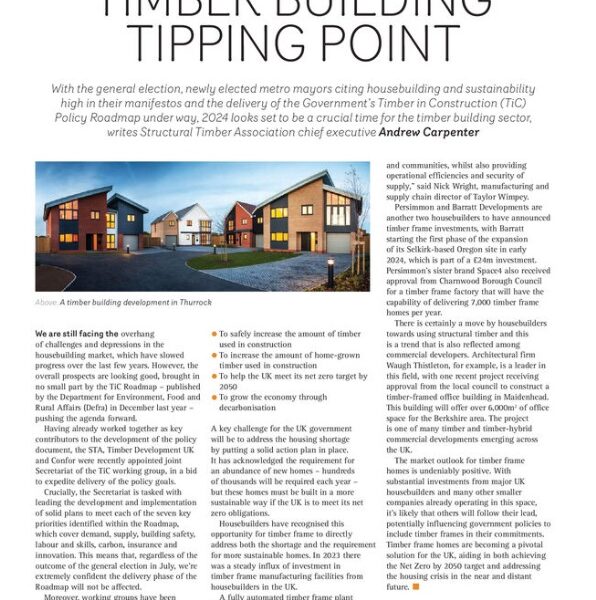Timber tipping point
17/07/2024

With a general election taking place, newly elected metro mayors citing housebuilding and sustainability high in their manifestos and the delivery of the Government’s Timber in Construction (TiC) Policy Roadmap underway, 2024 looks set to be a crucial time for the timber sector. Here, Andrew Carpenter, CEO of the STA looks at the current state of the timber construction market and the opportunities that lies ahead.
We are still facing the overhang of challenges and depressions on the housebuilding market, which have slowed progress over the last few years. However, the overall prospects are looking good brought in no small part by the TiC roadmap – published by the Department for Environment, Food and Rural Affairs (DEFRA) in December last year – pushing the agenda forward.
Having already worked together as key contributors to the development of the policy document, the STA, Timber Development UK and Confor were recently appointed joint Secretariat of the TiC working group, in a bid to expedite delivery of the policy goals.
Crucially, the Secretariat is tasked with leading the development and implementation of solid plans to meet each of the seven key priorities identified within the roadmap, which cover demand, supply, building safety, labour and skills, carbon, insurance and innovation. This means, that despite the outcome of the general election planned in July (at the time of writing), we’re extremely confident the delivery phase of the roadmap will not be affected.
Moreover, working groups have been established for each of the seven key priorities, which will take responsibility for driving forwards the 51 critical projects identified by DEFRA; some of which are industry focused and others that fall within the Government’s remit. These projects can be distilled into four key objectives:
- To safely increase the amount of timber used in construction
- To increase the amount of homegrown timber used in construction
- To help the UK meet its net zero target by 2050
- To grow the economy through decarbonisation
A key challenge for the UK Government, irrespective of the party that wins the general election, will be to address the housing shortage but putting a solid action plan in place. The Government has acknowledged the requirement for an abundance of new homes, hundreds of thousands will be required each year, but these homes must be built in a more sustainable way if the UK is to meet its net zero obligations.
Housebuilders have recognised this opportunity for timber frame to directly address both the shortage and the requirement for more sustainable homes. In 2023 there was a steady influx of investment in timber frame manufacturing facilities from housebuilders in the UK.
A fully automated timber frame plant in Peterborough was announced by Taylor Wimpey, citing “significant operational and environmental benefits” as the key driving factors for the investment. Nick Wright, manufacturing and supply chain director of Taylor Wimpey, said: “Timber frame is a key part of Taylor Wimpey’s long-term strategy to deliver low carbon, energy-efficient homes and communities, whilst also providing operational efficiencies and security of supply.”
Persimmon and Barratt Developments are another two housebuilders to have announced timber frame investments with Barratt starting the first phase of the expansion of their Selkirk-based Oregon site in early 2024, which is part of a £24million investment. Persimmon’s sister brand Space4 also received approval from Charnwood Borough Council for a timber frame factory that will have the capability of delivering 7,000 timber frame homes per year.
There is certainly a move by housebuilders towards using structural timber and this is a trend that is also reflected among commercial developers. Architectural firm Waugh Thistleton, for example, is a leader in this field with one recent project receiving approval from the local council to construct a timber-framed office building in Maidenhead. This building will offer over 6,000 square meters of office space for the Berkshire area. This project is one of many timber and timber-hybrid commercial developments emerging across the UK.
The market outlook for timber frame homes is undeniably positive. With substantial investments from major UK housebuilders and many other smaller companies already operating in this space, it’s likely that others will follow their lead, potentially influencing government policies to include timber frames in their commitments. Timber frame homes are becoming a pivotal solution for the UK, aiding in both achieving the Net Zero by 2050 target and addressing the housing crisis in the near and distant future.
Read the full article here.